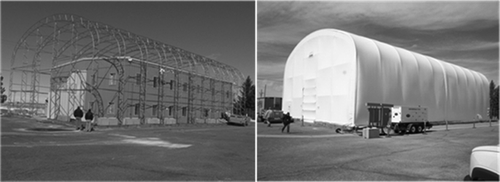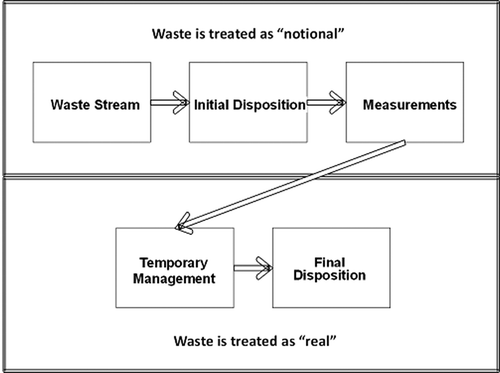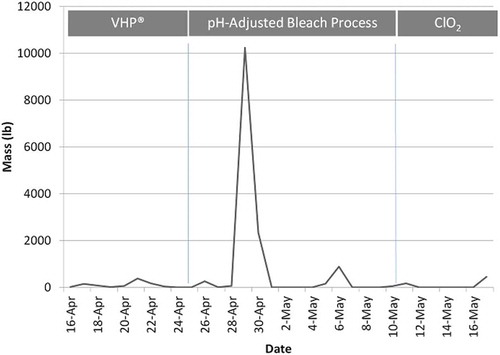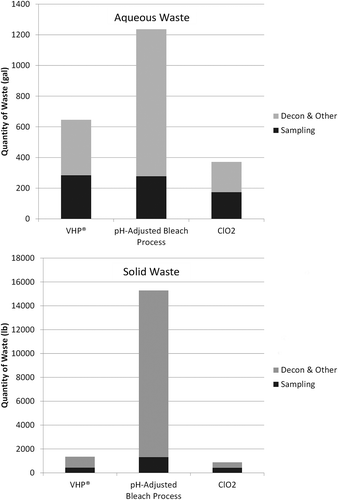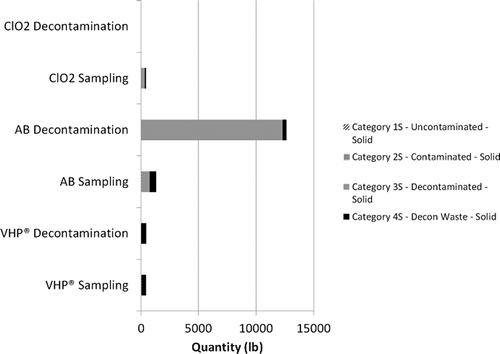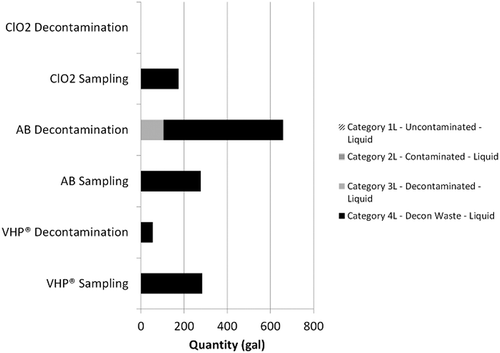ABSTRACT
The Bio-response Operational Testing and Evaluation (BOTE) Project was a cross-government effort designed to operationally test and evaluate a response to a biological incident (release of Bacillus anthracis [Ba] spores, the causative agent for anthrax) from initial public health and law enforcement response through environmental remediation. The BOTE Project was designed to address site remediation after the release of a Ba simulant, Bacillus atrophaeus spp. globigii (Bg), within a facility, drawing upon recent advances in the biological sampling and decontamination areas. A key component of response to a biological contamination incident is the proper management of wastes and residues, which is woven throughout all response activities. Waste is generated throughout the response and includes items like sampling media packaging materials, discarded personal protective equipment, items removed from the facility either prior to or following decontamination, aqueous waste streams, and materials generated through the application of decontamination technologies. The amount of residual contaminating agent will impact the available disposal pathways and waste management costs. Waste management is an integral part of the decontamination process and should be included through “Pre-Incident” response planning. Overall, the pH-adjusted bleach decontamination process generated the most waste from the decontamination efforts, and fumigation with chlorine dioxide generated the least waste. A majority of the solid waste generated during pH-adjusted bleach decontamination was the nonporous surfaces that were removed, bagged, decontaminated ex situ, and treated as waste. The waste during the two fumigation rounds of the BOTE Project was associated mainly with sampling activities. Waste management activities may represent a significant contribution to the overall cost of the response/recovery operation. This paper addresses the waste management activities for the BOTE field test.Implications: Management of waste is a critical element of activities dealing with remediation of buildings and outdoor areas following a biological contamination incident. Waste management must be integrated into the overall remediation process, along with sampling, decontamination, resource management, and other important response elements, rather than being a stand-alone activity. The results presented in this paper will provide decision makers and emergency planners at the federal/state/tribal/local level information that can be used to integrate waste management into an overall systems approach to planning and response activities.
Introduction
To date, the opportunity for a detailed analysis of waste management issues arising from a response to a biological contamination incident has not been available. The Bio-response Operational Testing and Evaluation (BOTE) Project was a cross-government effort designed to operationally test and evaluate a response to a biological incident (release of Bacillus anthracis [Ba] spores, the causative agent for anthrax) from initial public health and law enforcement response through environmental remediation. The BOTE Project (EPA, Citation2011; EPA, Citation2013) consisted of two distinct phases: Phase 1 was a field-level decontamination assessment, and Phase 2 was an operational exercise involving key federal agencies responsible for the forensic investigation, public health assessment, and remediation following a biological incident.
Phase 1 was designed to address site remediation after the release of a Ba simulant, Bacillus atrophaeus spp. globigii (Bg), within a facility in an operational setting, drawing upon the recent advances in both the biological sampling and decontamination areas. The objectives of Phase 1 were to conduct and evaluate field-level application of three decontamination technologies/protocols (surface cleaning with pH-adjusted bleach, fumigation with vaporous hydrogen peroxide [H2O2], and fumigation with chlorine dioxide [ClO2] gas), collect and analyze the results from the decontamination study, and perform a cost analysis of all aspects (i.e., including waste management) of the remediation approaches.
A key component of response to a biological contamination incident is the proper management of wastes and residues that are generated during the response. Waste management activities are woven throughout all response activities. Waste can be generated throughout the response and may include items such as packaging materials for sampling media, discarded personal protective equipment, items removed from the facility either prior to or following decontamination, various aqueous waste streams, and materials generated through the application of the decontamination technologies. Waste management activities may represent a significant contribution to the overall cost of the response/recovery operation (EPA, Citation2013). The amount of residual contaminating agent will in turn impact the available disposal pathways and waste management costs. BOTE provided an excellent opportunity to gain detailed insight into waste management activities in a field setting.
Methods
The BOTE test facility was Idaho National Laboratories (INL) building PBF-632, a two-story unoccupied office building () with approximately 4,025 square feet (ft2) per floor (90,000 cubic feet [ft3] total volume for the facility). Rooms on each floor were set up identically and configured to contain a mixture of porous and nonporous materials, to simulate both commercial office and residential environments. Each floor had an independent heating, ventilation, and air conditioning (HVAC) system that functioned only as an air handling unit for each floor of the facility (i.e., no heating or cooling). The facility was surrounded by a secondary containment enclosure to assist in preventing cross-contamination during the project activities.
Three rounds of testing were executed in BOTE Phase 1. Each of the three rounds included dissemination of the Bg spores throughout the facility, characterization sampling, decontamination, waste management, and post-decontamination sampling.
Dissemination of the Bg spores was performed by FLIR Systems, Inc. (27700 SW Parkway Ave., Wilsonville, OR 97070; formerly ICx Technologies, Inc., 4343 Pan American Freeway NE, Albuquerque, NM 87107) prior to each test event. A wet aerosol dispersion of Bg spores was used for this dissemination. The aerosol generator used for the dissemination was a microcontroller-driven medical nebulizer (Aeroneb Go 7070), manufactured by ICx (now FLIR Systems, Inc.). The nebulizer was a battery-powered aerosol generator that produces aerosol by the application of ultrasonic energy to a microporous disc. The generator was controlled by an on-board microcontroller controlling the output from micrograms to grams per minute. The release of the desired amount of the stock preparation of Bg spores occurred within several minutes of activation of the aerosol generator.
After each round, the facility was restored (reset) to its initial configuration for the start of the next round. For each round, Bg surface loadings (as determined by pre-decontamination surface sampling), room configurations, and sampling procedures were maintained to be consistent. Dissemination for each round was designed to result in a relatively higher level Bg surface loading (1E4 to 1E6 colony-forming units [CFU]/ft2) on the first floor and a lower level (1E2 to 2E2 CFU/ft2) on the second floor. The three decontamination methods that were used were:
Round 1: Fumigation with hydrogen peroxide (H2O2) vapor by STERIS Corporation, using their vaporized hydrogen peroxide (VHP®) technology.
Round 2: Surface decontamination using pH-adjusted bleach.
Round 3: Fumigation with ClO2 gas by Sabre Technical Services, LLC.
To achieve the objectives of the project, 3,259 samples were collected over all three rounds of sampling. Surface, air, sand, and wash water samples were collected. Surface sampling methods (cellulose sponge-stick wipes, swabs, vacuum socks, and Versalon wipes) were used to assess the concentration of spores pre- and post-decontamination; these data (with the exception of the Versalon wipes) were utilized primarily to assess the effectiveness of each decontamination method. The Versalon wipes were used to evaluate the EPA rapid-viability polymerase chain reaction (RV-PCR) analytical method. Sand samples were placed outside the building but within the secondary enclosure to assess whether viable Bg spores might have migrated outside the facility during the project activities (Silvestri et al., Citation2015). Wash water samples were utilized to assess the efficacy of on-site treatment of the wash water to inactivate Bg spores. The Building Restoration Operations Optimization Model (BROOM) tool (Sandia National Laboratories, Citation2006) was used to track sample collection, sample location, sample types, sample matrices, date, time, samplers used, and other pertinent data. shows the sequence of events that occurred for each round.
General waste management approach
The proper management of waste from the cleanup after a biological event is a key element of the remediation process. Different decontamination strategies result in generation of different quantities of waste and different characteristics of the waste, and the management of those wastes can significantly affect the overall remediation timeline, resource requirements, and costs.
The waste streams that are likely to be generated from a Ba response would include predominantly (1) personal protective equipment (PPE) items such as suits, gloves, and footwear covers (“booties”); (2) sampling waste; (3) porous materials removed from the facility either before or after decontamination operations; and (4) aqueous waste streams from decontamination/cleanup operations. Decontamination strategies will have a profound effect on the potential quantities of residual contaminating agent in the waste streams. The amount of residual contaminating agent will in turn impact the available disposal pathways and waste management costs.
One of the waste management challenges that the BOTE Project presented was the need to address waste issues (costs, quantities, logistics, etc.) as if the waste had been contaminated with Ba, even though a nonpathogenic surrogate was used (“notional” waste). In addition, as a constraint of the tests, all waste that was generated needed to be handled in accordance with INL waste management practices (“real” waste). This effort manifested itself mainly as a need to keep any biohazard-labeled bags (supplied to the sampling teams in the sampling kits) out of the trash. Discarding the biohazard-labeled bags in the trash would not be consistent with waste handling procedures associated with a real Ba contamination incident. The waste management practices from a real anthrax contamination incident would be determined by the waste acceptance criteria of the waste management facility to be utilized, as well as by any additional state requirements. For example, in the recent naturally occurring Ba response in Durham, NH (EPA Region 1 New England, Citation2008), the state indicated that if the pH-adjusted bleach decontamination process were followed properly, the waste could be disposed of as solid waste in a Resource Conservation and Recovery Act (RCRA) Subtitle D facility without any additional waste characterization sampling (provided that the facility agreed to accept the waste). It is advantageous, from a waste management cost standpoint, to make sure that the decontamination process (and sampling, if required) results in the least restrictive (i.e., Subtitle D) waste designation, thus reducing remediation costs. However, there is no guarantee that waste disposal capacity would be available in the state where the incident occurred, which may necessitate decisions by state regulatory personnel from states outside the state where the incident occurred. For this and other reasons, there is a need for pre-incident waste management planning so that these issues can be identified and resolved prior to an incident (EPA Region 1 New England, Citation2008). The results from this study may be expected to pertain to a single building contamination incident. Significant additional complexities may arise in the event of a wide-area incident involving many buildings.
It is necessary to estimate the cost of and issues related to management of the different “notional” waste streams generated during the BOTE Project properly while still properly addressing INL requirements for the “real” waste streams. To perform this estimate, a waste management approach was developed that identified, quantified, and characterized the waste after it left the building but prior to placing the waste in the dumpster for disposal through the INL waste management program. In this approach, the waste was handled as if it were Ba-contaminated waste up to the point at which it entered its temporary waste management staging area in preparation for final disposition in the INL waste management process.
To estimate the cost of and issues related to management of the different “notional” waste streams generated during the BOTE Project while still appropriately addressing INL requirements for the “real” waste streams, the waste management concept shown in was developed. “Initial disposition” refers to what happened to the “notional” waste immediately upon generation at the site. “Measurements” refers to the different measurements (e.g., weight, point of origin) that were taken on the “notional” waste after its initial disposition. “Temporary Management” refers to the near-term management of the “real” waste, such as temporary storage, mingling with or separation from other waste streams, and so on. “Final disposition” refers to the waste management activities related to introducing the “real” waste into the INL waste management processes. In other words, the waste was treated as Ba-contaminated waste up until the point at which the waste entered its temporary waste management stage in preparation for final disposition in the INL waste management process.
On-site activities
The operational implementation of the preceding waste management concept was put into practice at the BOTE Project for all three rounds of Phase 1 testing.
Waste that originated in the “Sampling Prep Trailer” (the on-site building that was used to prepare sampling kits and to allow the sampling teams to don their PPE) was periodically brought to the “Sampling and Decontamination Support Trailer” (the on-site building where samples were prepared for shipping to either on- or off-site laboratories) in bags and weighed on a platform scale (My Weigh, Inc., Phoenix, AZ, PN VHD). Weights were recorded either directly into a laboratory notebook or into an iPad device and transferred to the laboratory notebook as a backup. Once weighed, the waste was transferred into a nearby dumpster for eventual processing through the INL waste management process.
Solid waste that originated in the Personnel Decontamination Line was bagged by the Decontamination Line operations personnel and placed outside the Personnel Decontamination Line structure. The bags were weighed on the platform scale, the weights and point of origin were logged, and then the bags were put into the dumpster. Aqueous waste that was collected from the Personnel Decontamination Line was accumulated in a 55-gal drum. When the drum was full, the quantity was logged and the drum was replaced with an empty drum.
For the round 2 (pH-adjusted bleach) decontamination, a significant amount of material was bagged and removed from the building prior to the bleach spraying process. (Most of the material removed was porous and not expected to be decontaminated effectively.) Tracking the point of origin of the solid waste generated during the pH-adjusted bleach decontamination process to the individual room that the materials came from was desirable. To implement the tracking process, RFID chips, each with a unique serial number (Metalcraft, Inc., Mason City, IA, PN 40375-0001), were placed into the bags prior to closing. Bags were accumulated on a room-by-room basis so that their originating location could be tracked. The bags were then brought to a staging area (one on each floor of the building), opened, sprayed with pH-adjusted bleach, then closed and double-bagged. Due to the contaminant control procedures put in place to minimize cross-contamination of the less contaminated parts of the building (Floor 2) and the more contaminated parts of the building (Floor 1), the waste bags were directly thrown into a dumpster from the second floor and not weighed. Waste from the second floor was assumed to be equal to that from the first floor because the sets of rooms on both floors were similarly configured with virtually identical contents. All bags from the first floor were brought outside the Personnel Decontamination Line; the bags were weighed and waved in front of the RFID reader device (Motorola, Inc., Libertyville, IL, PN RD5000); the room of origin was logged; and then the bags were placed in a dumpster separate from the waste generated at the Personnel Decontamination Line.
The soapy water generated in the Personnel Decontamination Line was kept separate from the wastewater that contained bleach from the pH-adjusted bleach decontamination process.
Waste characterization, acceptance, and preplanning implications
For the purposes of separating the waste streams for waste treatment and disposal, the various “real” waste streams were categorized according to the categories listed in , based on whether they had ever been contaminated by the Bg, whether they were liquid (aqueous) or solid, and whether they had been subjected to the decontamination processes in the various rounds. In addition, categories were created for waste generated as a result of decontamination operations, such as PPE waste from the personnel decontamination line, or liquid bleach residues vacuumed up from the floor following the pH-adjusted bleach decontamination process from round 2. In a real biological contamination incident, once a stream has been determined to be a waste, the next step is to characterize the waste in accordance with the procedures established by the state in which the waste was generated. These procedures are especially important for biological agents because biological agents are not addressed as part of the Federal Hazardous Waste Framework within the RCRA (U.S. Statute, Citation1976). As a result, individual state waste management officials must be consulted regarding how these agents are characterized/classified within their respective states. These represent further reasons why a “Pre-Incident” waste management plan is needed to document these requirements prior to an incident, as identified in the After Action Report for the Durham, NH, response (EPA Region 1 New England, Citation2008). In addition, while the state has a lot of say in the categorization of the waste, it is the owners/operators of waste management facilities (e.g., landfills, commercial autoclaves, various types of incinerators) (EPA, Citation2003) who ultimately have to accept the waste and may have in their permits waste acceptance criteria in additional to the criteria that the state requires. A combination of the identification of state waste management requirements for these waste streams and the waste acceptance criteria and the willingness of owner/operators of waste management facilities to accept the waste determines the final disposition of these waste streams. There may be other considerations as well that impact the suitability of a given waste management facility to handle incident-derived wastes (e.g., facility willingness to accept the waste, facility compliance history, environmental justice, waste handling capacity, public acceptance). Pre-incident waste management planning is therefore a real need, so that these issues can be identified and resolved prior to an incident. Analysis of waste management requirements for this single building remediation does not address the overwhelming complexities associated with a wide area anthrax release. Facilities outside the state of the release may also be needed to support the response. A more accurate statement is therefore to discuss waste management in terms of the acceptance of the state and owners/operators regardless of where the release occurs. The complexity of multistate response also provides further support for the need for pre-incident waste management planning.
Table 1. “Real (INL)” waste categories.
lists the various waste streams and describes the initial disposition, measurements, and frequency of measurements of the waste materials. The final disposition of this waste is based on INL waste management procedures with state input. However, if this were an actual incident involving a release of Ba, waste management procedures would be developed in accordance with state requirements with collaborative technical support from appropriate federal agencies as requested.
Table 2. BOTE Project waste management measurements and frequency.
Results
The pH-adjusted bleach decontamination process generated significantly more waste than both of the fumigation rounds, largely due to the amount of materials that were soaked with bleach and likely not amenable to reuse, even when dried. There was also more aqueous waste generated during the pH-adjusted bleach round than during the fumigation rounds due to residual bleach solution that was collected following decontamination. The waste generation data are subject to the caveat that, to the extent possible, generated waste was assigned to the activities that resulted in the generation of that particular batch of waste. However, due to the duration of some of the workdays during the BOTE Project Phase 1 testing, some activities were deferred until the following day, and this deferral may have resulted in some waste being assigned to the activities associated with the following day. In addition, since this was a research study, where multiple co-located samples were acquired using several different sampling media, the total number of samples that were taken was likely much higher than would be acquired during an actual response.
Due to logistical issues with handling the removed materials that were collected from the second floor of the building during round 2 (pH-adjusted bleach decontamination process) while maintaining the contaminant control procedures, the weights of the removed materials from the second floor were not measured directly. Rather, the quantities of materials removed from the first floor were doubled. In addition, although the laminate floors were not removed prior to the pH-adjusted bleach decontamination process, the laminated floors were severely warped by the pH-adjusted bleach spray and in a normal decontamination situation would have required replacement. Also, the supply-side HVAC ductwork might have been removed as part of the pH-adjusted bleach decontamination process and later replaced. The laminate floors and HVAC duct were therefore notionally added to the waste stream for the pH-adjusted bleach decontamination process, as well as to the refit cost in the cost analysis. These issues all combined to result in the pH-adjusted bleach decontamination process generating significant quantities of waste relative to the fumigation rounds. lists the amount of solid and aqueous waste generated during each test activity, categorized as per . Note that waste related to dissemination of the spores represents a total for all three rounds.
Table 3. Waste data from BOTE Phase 1.
Summarizing the daily solid waste data on the basis of total amount collected and plotting the results yields . The materials removed from the pH-adjusted bleach decontamination process in round 2 contributed significantly to the overall waste stream, as well as requiring much more support for handling and packaging than the other days of the testing.
Discussion
shows the distribution of waste by activity (sampling or decontamination/other) for aqueous and solid waste. The vast majority of the waste from round 2 with the pH-adjusted bleach decontamination process was generated during the decontamination itself, whereas for round 1 and round 3, a significant fraction of the waste was generated during sampling operations. Note that any differences in quantities of waste generated during sampling operations represent the variability of sampling waste generation (i.e., sampling activities for the three rounds of the BOTE Project were virtually identical). Also note that the sampling approach was designed for the BOTE study and not an actual Ba incident, so the numbers of samples (and associated waste generated by sampling) was biased high.
shows the quantities of solid waste as a function of waste category. The largest amount of solid waste generated occurred during round 2 (pH-adjusted bleach decontamination process), where porous surfaces were removed, bagged, decontaminated ex situ (note that due to the research study nature of BOTE, some of this waste was notionally decontaminated ex situ), and treated as waste (Category 3S). Waste generated during round 1 (fumigation with VHP) included only category 4S waste such as PPE and sampling waste (e.g., packaging) for both building decontamination and sampling. A small amount of decontaminated solid material was also generated during the post-decontamination sampling in round 2. No solid waste was generated during building decontamination using ClO2, but a small amount of solid waste (Category 4S) from PPE and sample kit packaging was generated during ClO2 sampling. These materials were managed as described in . Foam materials (452 lb) were removed after the ClO2 fumigation (chairs, chair cushions, and mattresses) in preparation for turning the building back over to INL, but these materials were not included in the waste tally because they were not damaged and would not have been replaced had there been an additional round following ClO2 fumigation.
shows the quantities of aqueous waste as a function of waste category. The largest amount of aqueous waste was generated during round 2 (pH-adjusted bleach decontamination process) due to decontamination of the building using pH-adjusted bleach (Category 4L). Aqueous decontamination waste was also generated during all three rounds during sampling; this waste consisted of the rinsate recovered from the Decontamination Line.
Coordination of waste management procedures with the state waste management officials is critical. For example, in the recent naturally occurring Ba response in Durham, NH (EPA Region 1 New England, Citation2008), the state indicated that if the pH-adjusted bleach decontamination process were properly followed, the waste could be disposed of as solid waste in a RCRA Subtitle D facility without any additional waste characterization sampling. It must be reiterated that regardless of what the state indicates, a waste management facility must still be willing to accept this waste. In a real Ba response, it is advantageous to ensure that the decontamination process (and sampling, if required) results in the least restrictive (e.g., Subtitle D) waste designation, thus reducing remediation costs.
Overall, the management of the waste from the BOTE Project presented several challenges, including:
Difficulty weighing and handling the waste from the second floor of the building during the pH-adjusted bleach decontamination process while maintaining the contaminant control measures necessary to prevent cross-contamination of samples.
Difficulty extrapolating waste management practices from waste containing a nonpathogenic organism to waste management of wastes containing Ba.
Difficulty specifying appropriate waste characterization strategies (i.e., sampling procedures for bagged waste are not well-defined; bagging waste is logistically difficult, and the effectiveness of using a surface sampling technique on bags of wetted building materials is questionable).
Conclusions
Overall, the pH-adjusted bleach decontamination process generated the most waste from building decontamination efforts. ClO2 fumigation generated the least waste from building decontamination efforts. A majority of the solid waste generated during the pH-adjusted bleach decontamination was the nonporous surfaces that were removed, bagged, decontaminated ex situ, and treated as waste. The waste during rounds 1 and 3 was associated mainly with sampling activities.
The use of RFID chips to track the source of the waste worked very well in spite of fears that the presence of the pH-adjusted bleach in the bags might interfere with reading the RFID chip information properly. This successful proof-of-concept test using RFID chips may provide for early waste segregation opportunities and may lead to reduced cleanup times and remediation costs.
If the state agrees to accept aqueous wastes at a POTW facility and the solid waste in a RCRA Subtitle D facility, the waste management is greatly simplified.
Other variants on the procedures that were used may also potentially ease waste management activities. Such variants would include using lined roll-off bins to reduce the need for double-bagging waste. Future efforts to identify more effective waste management procedures may include evaluation of such operational variants.
Due to the complexity of waste management, it should be an integral part of the decontamination process and should be included as a specific function through “pre-incident” response planning. Documentation of waste management activities should be specified within a waste management plan. The US EPA has online resources to assist in pre-incident waste management planning (EPA, Citation2015).
Acknowledgments
The authors give special acknowledgment to the following individuals: Shawn Ryan of EPA and Chris Russell (formerly of DHS) for organizing and leading the BOTE effort; Shannon Serre of EPA for managing the overall BOTE Phase 1 effort; Martin Meltzer (Centers for Disease Control and Prevention, CDC) for his valuable contributions to the cost and waste management groups; Erica Canzler (EPA) for leading the BOTE Phase 2 effort; and Eletha Brady-Roberts for overseeing the Quality Assurance activities. Dino Mattorano of EPA led the sampling activities. Sharna Rossberg of INL deserves special acknowledgment for tracking waste generation and personnel activities inside the building during the entire duration of BOTE. Charlena Bowling (EPA), Kathy Nickel (EPA), and Melissa Ivancevich (Dynamac) are thanked for their efforts in weighing the waste bundles during the pH-adjusted bleach decontamination round. Finally, Joan Bursey of the Senior Environmental Employee (SEE) program, who performed the technical editing of the very large BOTE report through several revisions, deserves special mention.
Disclaimer
The Bio-Response Operation Testing and Evaluation (BOTE) Project was a joint effort among the Department of Homeland Security Science and Technology Directorate (DHS S&T), the U.S. Environmental Protection Agency (EPA), and the Centers for Disease Control and Prevention (CDC). DHS and EPA managed and funded this effort through an interagency agreement (IA DW-89923315) with the Idaho National Laboratory (INL) for providing and establishing the test bed and on-site execution support. This paper has been subjected to the agency’s review and has been approved for publication. Note that approval does not signify that the contents necessarily reflect the views of the agency. Mention of trade names, products, or services does not convey official EPA approval, endorsement, or recommendation.
Additional information
Notes on contributors
P. Lemieux
Paul Lemieux is a chemical engineer with EPA’s National Homeland Security Research Center within their Office of Research and Development.
J. Wood
Joe Wood is a senior research engineer with EPA’s National Homeland Security Research Center within their Office of Research and Development.
J. Drake
John Drake is a retired senior research engineer formerly with EPA’s National Homeland Security Research Center within their Office of Research and Development.
S. Minamyer
Scott Minamyer is a retired environmental scientist formerly with EPA’s National Homeland Security Research Center within their Office of Research and Development.
E. Silvestri
Erin Silvestri is a biologist with EPA’s National Homeland Security Research Center within their Office of Research and Development.
C. Yund
Cynthia Yund is an environmental health scientist with EPA’s National Homeland Security Research Center within their Office of Research and Development.
T. Nichols
Tonya Nichols is the Division Director of the Threat and Consequence Assessment Division of EPA’s National Homeland Security Research Center within their Office of Research and Development.
M. Ierardi
Mario Ierardi is the Homeland Security Team Leader in the Waste Characterization Branch of EPA’s Office of Resource Conservation and Recovery.
B. Amidan
Brett Amidan is a Research Scientist in the Applied Statistics and Computational Modeling group at Pacific Northwest National Laboratory.
References
- Sandia National Laboratories. 2006. BROOM (Building Restoration Operations Optimization Model) Beta Version 1.0. Albuquerque, NM: Sandia National Laboratories.
- Silvestri, E., S. Perkins, R. Lordo, W. Kovacik, T. Nichols, C. Bowling, D. Griffin, and F. Schaefer. 2015. Observations on the migration of Bacillus spores outside a contaminated facility during a decontamination efficacy study. J. Bioterrorism Biodefense 6(2). doi:10.4172/2157-2526
- U.S. EPA. 2003. Report on the Homeland Security Workshop on Transport and Disposal of Wastes From Facilities Contaminated With Chemical or Biological Agents. EPA/600/R-04/065. http://cfpub.epa.gov/si/si_public_record_report.cfm?dirEntryId=218767&fed_org_id=1253&subject=Homeland+Security+Research&view=desc&sortBy=pubDateYear&count=25&showCriteria=1&searchall=Report+on+the+Homeland+Security+Workshop+on+Transport+and+Disposal+of+Wastes+From+Facilities+Contaminated+With+Chemical+or+Biological+Agents&submit=Search
- U.S. EPA. 2011. Bio-Response Operational Testing and Evaluation (BOTE) Project Phase 2 After Action Report. Washington, DC.
- U.S. EPA. 2013. Bio-Response Operational Testing and Evaluation (BOTE) Project: Phase 1: Decontamination Assessment. Washington, DC. EPA/600-R-13-168.
- U.S. EPA. 2015. Wastes—Waste Management for Homeland Security Incidents. http://www.epa.gov/solidwaste/homeland/plan.htm (accessed June 9, 2015).
- U.S. EPA Region 1 New England. 2008. After Action Report—Danbury Anthrax Incident. Available upon request from EPA region 1.
- U.S. Statute. 1976. Resource Conservation and Recovery Act. P.L. 94–580, 90 Stat. 2795, 42 U.S.C. § 6901 et seq.

